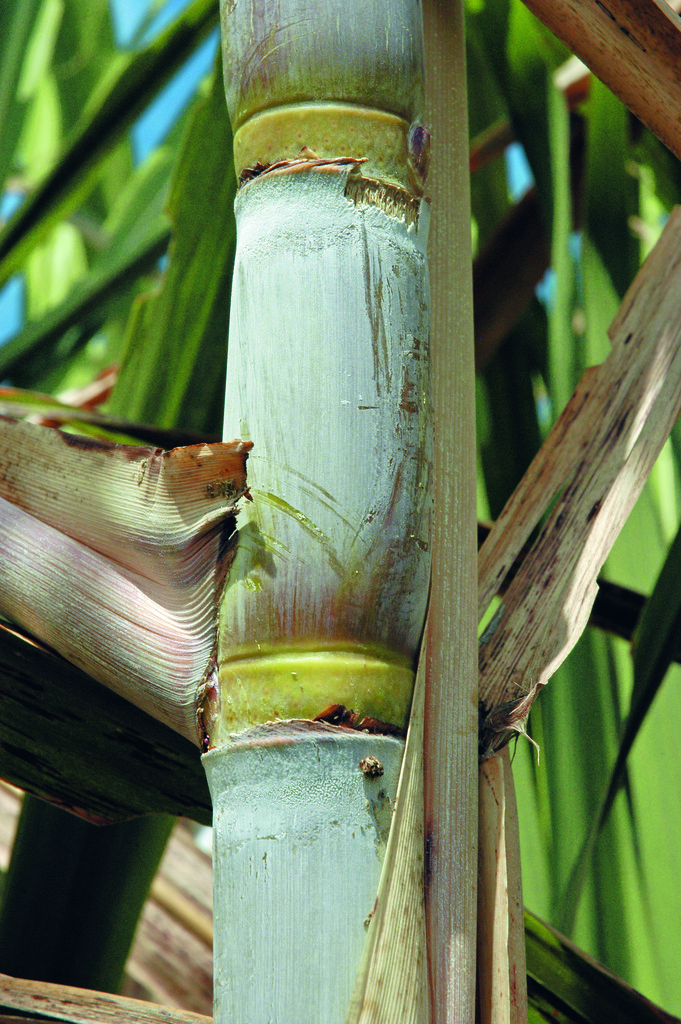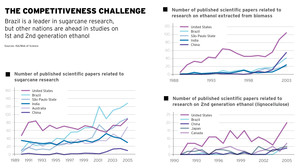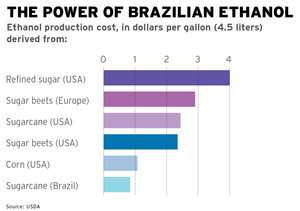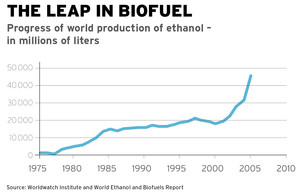 Eduardo CesarResearchers from the State of São Paulo are being summoned to take part in a huge research effort focused on improving the productivity of Brazilian ethanol and moving forward in terms of basic science and technological development related to the generation of energy based on biomass. The ambitious objective of the Programa FAPESP de Pesquisa em Bioenergia/BIOEN bioenergy research program, launched on May 3, is to stimulate and organize research activities at local institutions and improve existing expertise in this field. “Brazil has distinct advantages in the production of first-generation ethanol, based on the fermentation of sucrose; but there are several challenges that we still have to overcome to improve productivity”, says Carlos Henrique de Brito Cruz, the scientific director of FAPESP. “There are also unique opportunities related to the technological development of second-generation ethanol, produced from cellulose, which has been a target for research in many countries. The BIOEN is active on both fronts”, he states.
Eduardo CesarResearchers from the State of São Paulo are being summoned to take part in a huge research effort focused on improving the productivity of Brazilian ethanol and moving forward in terms of basic science and technological development related to the generation of energy based on biomass. The ambitious objective of the Programa FAPESP de Pesquisa em Bioenergia/BIOEN bioenergy research program, launched on May 3, is to stimulate and organize research activities at local institutions and improve existing expertise in this field. “Brazil has distinct advantages in the production of first-generation ethanol, based on the fermentation of sucrose; but there are several challenges that we still have to overcome to improve productivity”, says Carlos Henrique de Brito Cruz, the scientific director of FAPESP. “There are also unique opportunities related to the technological development of second-generation ethanol, produced from cellulose, which has been a target for research in many countries. The BIOEN is active on both fronts”, he states.
The program is comprised of five items. One of them is research on biomass with a focus on the improvement of sugarcane . The second item is the manufacturing process of biofuels. The third item is linked to applications of ethanol for automobile engines. The fourth item is connected with studies on biorefineries and alcohol chemistry. And the fifth item will focus on the social and environmental impacts of biofuels. “The challenge is to establish a new research and development model that will have real impact on the improvement of cultivars, on increasing the efficiency of the ethanol producing processes, and on evaluating the impact of biofuels on several sectors of society”, explains Glaucia Mendes Souza, a researcher at the Chemistry Institute of the University of São Paulo/USP and coordinator of the BIOEN program.
Investments in the projects are expected to total approximately R$ 38 million; the funds will be provided by FAPESP (R$ 19 million) and by the CNPq, Brazil’s National Scientific and Technological Development Council – R$ 10,2 million for scholarship grants; another R$ 8.8 million will come from the Program for the Support of Centers of Excellence/ Pronex. Agreements were also entered into within the scope of the BIOEN; these agreements will focus on networking research efforts with corporations and other entities. One of these agreements entails the first call for proposals under the Convênio FAPESP/Dedini para Apoio à Pesquisa sobre Processos Industriais para a Fabricação de Etanol de Cana-de-açúcar, a cooperation agreement between FAPESP and Dedini to support research studies on industrial processes in the manufacturing of sugarcane ethanol; this agreement provides for initial investments of R$ 20 million in cooperative projects involving specialists from the Dedini company and from São Paulo State universities and research institutions. The Convênio FAPESP/Dedini agreement provides for investments of R$ 100 million in five years, the funding of which will be shared equally by both partners.
Dedini is not the only company partnering with FAPESP in the field of biofuel research. In 2006, FAPESP, together with the BNDES, entered into an agreement with Oxiteno, owned by the Grupo Ultra, the objective of which was the development of seven cooperation projects, ranging from studies on the enzyme hydrolysis process of sugarcane bagasse to obtain sugars up to the production of cellulose ethanol. At the beginning of this year, FAPESP and Braskem also entered into an agreement for the development of biopolymers. In addition to the agreements with these three companies, the BIOEN Program has put out a call for proposals at an amount of R$ 5 million under the agreement between FAPESP and the Fundação de Amparo à Pesquisa de Minas Gerais/Fapemig foundation, the objective of which is research into biofuels. The Program is also the recipient of R$ 10 million, provided by FAPESP, for regular aid and for the program Apoio ao Jovem Pesquisador, which provides grants to young researchers. The calls announced at the beginning of June encompass investments of R$ 73 million.
 Brazil’s sugarcane agribusiness turns over R$ 40 billion a year. The 2007/2008 harvest is expected to total 547 million tonnes of sugarcane , 15.2% more than the previous harvest. Half of this amount is used to produce ethanol, which makes Brazil the world’s second biggest fuel producer. The United States, where heavily subsidized ethanol is extracted from corn, ranks first. The State of São Paulo accounts for two thirds of the domestic production. Projections are that Brazil will have to double its production within the next five to seven years to meet local and international demand for ethanol. This will require building new mills, developing sugarcane plantations, improving management, and, above all, achieving gains in productivity. One of BIOEN’s main goals is to create the expertise that will help speed up the development of new sugarcane varieties able to fuel these productivity gains. In São Paulo, increased productivity can be achieved, for example, through the advent of sucrose-rich cultivars, as the expansion of sugarcane plantations is blocked by the lack of available farmland. Expansion is more feasible in the Planalto Central region – farmlands with a huge potential have been mapped out in the north of the State of Tocantins, in the south of the States of Maranhão, Mato Grosso and Goiás, and in the Triangulo Mineiro region. However, there is still a need to develop a wider range of varieties adapted to drier regions. “The availability of drought-resistant cultivars will be necessary for the expansion of sugarcane in this region, because this will make it feasible to resort to pasture land and might reduce the expansionist pressure on lands in the Cerrado region and in the rain forest region”, says Glaucia Souza. “armers from the Northeast will also benefit from drought-resistant cultivars that could significantly increase the region’s productivity”, she states.
Brazil’s sugarcane agribusiness turns over R$ 40 billion a year. The 2007/2008 harvest is expected to total 547 million tonnes of sugarcane , 15.2% more than the previous harvest. Half of this amount is used to produce ethanol, which makes Brazil the world’s second biggest fuel producer. The United States, where heavily subsidized ethanol is extracted from corn, ranks first. The State of São Paulo accounts for two thirds of the domestic production. Projections are that Brazil will have to double its production within the next five to seven years to meet local and international demand for ethanol. This will require building new mills, developing sugarcane plantations, improving management, and, above all, achieving gains in productivity. One of BIOEN’s main goals is to create the expertise that will help speed up the development of new sugarcane varieties able to fuel these productivity gains. In São Paulo, increased productivity can be achieved, for example, through the advent of sucrose-rich cultivars, as the expansion of sugarcane plantations is blocked by the lack of available farmland. Expansion is more feasible in the Planalto Central region – farmlands with a huge potential have been mapped out in the north of the State of Tocantins, in the south of the States of Maranhão, Mato Grosso and Goiás, and in the Triangulo Mineiro region. However, there is still a need to develop a wider range of varieties adapted to drier regions. “The availability of drought-resistant cultivars will be necessary for the expansion of sugarcane in this region, because this will make it feasible to resort to pasture land and might reduce the expansionist pressure on lands in the Cerrado region and in the rain forest region”, says Glaucia Souza. “armers from the Northeast will also benefit from drought-resistant cultivars that could significantly increase the region’s productivity”, she states.
Sugarcane varieties, with high sugar or fiber content, adapted to the various climates and soils found in Brazil, have been under development for years by means of traditional genetic improvement techniques. The intention of the BIOEN Program is to help speed up the development of these varieties by means of the genetic manipulation of the plants’ genetic metabolism, thus generating competitive advantages for Brazil’s production.
The BIOEN’s starting point was the interaction of a group of researchers who study the so-called Express Sequence Tags/ESTs, under the FAPESP Sucest (Sugarcane EST) Program. Widely known as the Sugarcane Genome (Genoma Cana), this project was conducted from 1999 to 2003 by approximately 240 researchers under the coordination of biologist Paulo Arruda. The project was funded by FAPESP and by the Cooperativa dos Produtores de Açúcar e Álcool do Estado de São Paulo/Coopersucar cooperative of sugar and ethanol producers. “We achieved 238 thousand ESTs; then we identified the genes involved in this process, studied the associated functions and prepared the tissue matrix to help the creation of a more efficient generation of genetically modified plants”, says Glaucia Souza. “We already have 348 pieces of data on genes associated with the synthesis of sucrose”, she adds.
The current challenge researchers face is to identify the regions of the sugarcane genome that are responsible for regulating the expression of the genes mapped by the researchers. Knowing where the physical site of the genes is and the dosage of their alleles, along with the environment in which they are inserted, will help achieve efficiency in terms of using molecular markers to improve sugarcane crops and processing. The ultimate goal is for this knowledge to help drive the development of new varieties, a process which currently takes at least 10 years, and makes this process more competitive and less expensive. Nowadays, improvement programs are based on the selection of future varieties (genotypes) carried out in the field, by means of the evaluation of the characteristics of interest found in each genotype. This process is conducted on thousands of plants every year, and narrowed down to some high-potential varieties. “The idea is to reduce the number of plants evaluated in the field, by resorting to data on molecular markers, to previously select varieties linked to the genes of interest”, says agronomy engineer Anete Pereira de Souza, coordinator of the project, a professor at the Department of Genetics and Evolution of the Biology Institute and a researcher at the Molecular Biology and Genetic Engineering Center/ Cbmeg, both at the State University of Campinas/ Unicamp. “The identification of molecular markers associated with the characteristics of interest is extremely important for guidance on interbreeding in sugarcane improvement programs”, states researcher Marie-Anne Van Sluys, a professor at the Botanic Department of the University of São Paulo/USP’s Biosciences Institute. Both Anete and Marie-Anne will coordinate the research studies within the scope of the BIOEN Program. The task of identifying the molecular markers is far from easy. The sugarcane genome is three times bigger than the human genome; to make things even more difficult, the sugarcane genome can have up to ten non-identical copies of each chromosome, as opposed to the human genome, which has only two.
The BIOEN Program will also focus on studying the plant’s anti-pest defense mechanism. The interaction between sugarcane and insects is a dynamic system, subject to on-going variations. “The plants develop different mechanisms to reduce insect attacks, including specific responses that activate different metabolic paths and significantly alter their chemical and physical characteristics”, says Glaucia Souza. On the other hand, insects develop strategies to overcome the plants’ defense barriers; these strategies allow the insects to feed, develop and reproduce in their hosts. One of the specific objectives is to study the giant moth borer, one of the pests that attack sugarcane crops in the Northeast Region; the existence of the giant moth borer was recently reported in some sugarcane growing regions in the Southeast.
 Eduardo CesarAnother objective is to understand the function of specific defense proteins found in sugarcane that defend the plant from attacks by the moth borer. Another issue covered by the research studies is how sugarcane will respond to climate change. This know-how will help develop more resistant varieties to possible increases related to rainfall and heat and the expected advance of pests. It is already common knowledge that high concentrations of carbon gas increase photosynthesis and biomass volume, which allows one to predict productivity increases. “On the other hand, very little is known about hormone control mechanisms, their relationship with the carbon metabolism and the genetic transcription networks associated with it”, says Marcos Buckeridge, a professor at the Department of Botanic at USP’s Biosciences Institute, who is also one of the coordinators of the BIOEN Program. “Familiarity with such processes can potentially expose which points of the sugarcane metabolism could be altered to produce varieties able to adapt to climate changes”, says Buckeridge. The search for sources for environment-friendly biofuel production, such as ethanol obtained from the polysaccharides found in native tree seeds grown in the midst of sugarcane plantations, will also be a research target. “Agro-forest systems could well be the new model capable of increasing the production of renewable energy, in a harmonious manner that results in social benefits and has minimum environmental impact”, states Buckeridge.
Eduardo CesarAnother objective is to understand the function of specific defense proteins found in sugarcane that defend the plant from attacks by the moth borer. Another issue covered by the research studies is how sugarcane will respond to climate change. This know-how will help develop more resistant varieties to possible increases related to rainfall and heat and the expected advance of pests. It is already common knowledge that high concentrations of carbon gas increase photosynthesis and biomass volume, which allows one to predict productivity increases. “On the other hand, very little is known about hormone control mechanisms, their relationship with the carbon metabolism and the genetic transcription networks associated with it”, says Marcos Buckeridge, a professor at the Department of Botanic at USP’s Biosciences Institute, who is also one of the coordinators of the BIOEN Program. “Familiarity with such processes can potentially expose which points of the sugarcane metabolism could be altered to produce varieties able to adapt to climate changes”, says Buckeridge. The search for sources for environment-friendly biofuel production, such as ethanol obtained from the polysaccharides found in native tree seeds grown in the midst of sugarcane plantations, will also be a research target. “Agro-forest systems could well be the new model capable of increasing the production of renewable energy, in a harmonious manner that results in social benefits and has minimum environmental impact”, states Buckeridge.
Only sucrose, which accounts for one third of the sugarcane biomass, is used to produce sugar and ethanol. It is a fact that Brazil uses sugarcane bagasse to generate power in the mills or to produce animal feed – this use was responsible for an impressive increase in efficiency. The huge challenge is how to convert the cellulose that is found in sugarcane bagasse and straw into ethanol – these are enzyme hydrolysis or chemical-physical processes that would allow the cellulose’s carbon units and those of hemicelluloses to be fermented. The development of cellulose technology is at the core of a global race for the production of energy from renewable sources. Nowadays, this process is extremely costly and is far from being economically feasible. If the researchers find ways of reducing these costs, the use of two thirds of the sugarcane could, in the long term, dramatically increase Brazil’s ethanol production.
Under the BIOEN Program, the researchers will also study the physiology of sugarcane cell walls. They are comprised of cellulose, hemicellulose and pectin interwoven in such a way that it is extremely difficult to efficiently extract the energy from their chemical bonds. The program will invest in learning how this cell wall is constituted to alter its structure and create varieties in which the cell wall degradation is simpler. “We already know the composition and the structure of the polysaccharides in the cell wall of the leaves, the culms and the buds. Therefore, we know which bonds have to be broken down to produce sugar”, says Buckeridge. “We also have a list of 469 genes related to the cell wall and we are stepping up our studies to understand how some of the enzymes function. But this is a laborious task, because not only do we need to understand how each enzyme functions, but also how the enzymes work together. Our long-term objective is to make the plant, at a certain moment of development, begin to degrade its own cell wall, so that after it is harvested, it becomes easier to conclude the hydrolysis process by using the microorganism enzymes”, stated the researcher.
 Research on how to obtain ethanol from cellulose involves physical, chemical or biological processes – nobody knows which of these three will be more efficient. “Until two years ago, the production of ethanol in large quantities was a Brazilian issue. Now, given the interest of the developed countries in the development of these technologies, it means we have to contend with competitors that oblige us to incorporate advanced science to a much greater extent”, says Brito Cruz, scientific director of FAPESP, who emphasizes the importance of investing simultaneously in traditional ethanol and in cellulose ethanol. “The idea that second generation ethanol is better is still controversial. There is no doubt that it will be advantageous for countries that are unable to produce first generation ethanol. Research studies indicate that first generation ethanol will continue being better than second generation ethanol for many years to come. Nonetheless, second generation ethanol will be very attractive, given the current oil prices”, he states.
Research on how to obtain ethanol from cellulose involves physical, chemical or biological processes – nobody knows which of these three will be more efficient. “Until two years ago, the production of ethanol in large quantities was a Brazilian issue. Now, given the interest of the developed countries in the development of these technologies, it means we have to contend with competitors that oblige us to incorporate advanced science to a much greater extent”, says Brito Cruz, scientific director of FAPESP, who emphasizes the importance of investing simultaneously in traditional ethanol and in cellulose ethanol. “The idea that second generation ethanol is better is still controversial. There is no doubt that it will be advantageous for countries that are unable to produce first generation ethanol. Research studies indicate that first generation ethanol will continue being better than second generation ethanol for many years to come. Nonetheless, second generation ethanol will be very attractive, given the current oil prices”, he states.
Dedini, which entered into a partnership agreement with FAPESP, has already developed and patented a process to obtain ethanol from cellulose; the company is now working on improving this process. “It is a great privilege to be able to count on the know-how of the research centers to jointly solve technological problems linked to ethanol production”, says José Luiz Olivério, vice-president of Dedini. The call for proposals establishes that, in the next three months, researchers may submit projects on subjects related to the improvement of traditional processes, such as the production of ethanol or the use of sugarcane bagasse to generate electricity, and the development of innovative processes, such as obtaining ethanol from cellulose by means of acid or enzyme hydrolysis at a competitive cost. The proposals will be selected by a selection committee and the selected projects will be supervised by research and development experts from Dedini.
 Discussion on the possible impact of sugarcane plantations for ethanol in the production of food products, which has gained momentum in the last few months, may be the focus of research projects in the fifth category of the program – this category will analyze the social and environmental impacts of the increased production of bioenergy. “It has already been clearly shown that the costs of food products are linked to the increase in petroleum prices, which affects transportation, and the increase in global consumption, caused by the speedy growth of the Indian and the Chinese economies”, says Brito Cruz. “The BIOEN Program’s concern is not tied to this collective debate, but rather to the fact that until today the development of agriculture around the world has always been linked to the production of food and now it will also be linked to the production of fuel for vehicles. This will probably change the reasoning that guides the world’s agricultural development, and very little is known about this issue”, he states.
Discussion on the possible impact of sugarcane plantations for ethanol in the production of food products, which has gained momentum in the last few months, may be the focus of research projects in the fifth category of the program – this category will analyze the social and environmental impacts of the increased production of bioenergy. “It has already been clearly shown that the costs of food products are linked to the increase in petroleum prices, which affects transportation, and the increase in global consumption, caused by the speedy growth of the Indian and the Chinese economies”, says Brito Cruz. “The BIOEN Program’s concern is not tied to this collective debate, but rather to the fact that until today the development of agriculture around the world has always been linked to the production of food and now it will also be linked to the production of fuel for vehicles. This will probably change the reasoning that guides the world’s agricultural development, and very little is known about this issue”, he states.
The BIOEN Program also intends to attract and train people qualified to work in bioenergy research. The idea is to create the conditions to strengthen the state’s leadership in this field, by means of actions that will allow academic research to be conducted within competitive international standards, expand the contribution of research institutions and centers already developing research studies in this field, and establish a research network in partnership and collaboration with companies.
Republish